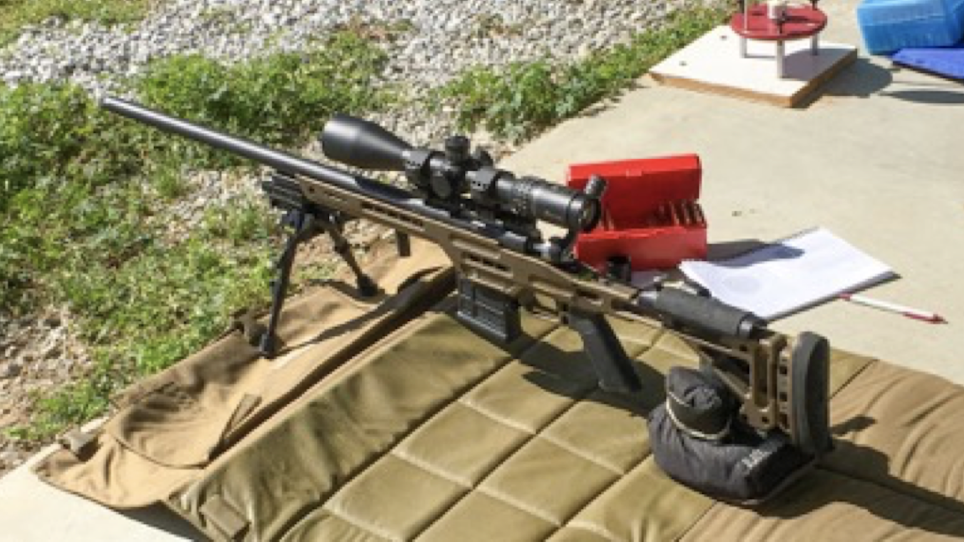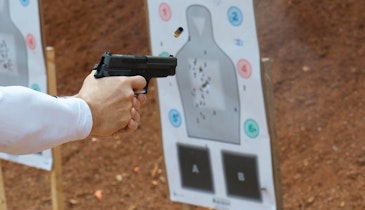What's harder to understand than Common Core math? Ballistic science, that's what. Unintelligible or not, it's important to help your customers understand the underlying concepts because hitting anything past a couple of hundred yards relies on knowing how to predict the effects of bullet drop and wind. Even the routine task of zeroing of a rifle can be made much, much easier through fundamental understanding of ballistic science and use of a ballistic computer.
The good news is that we have a myriad of ballistic calculator tools available to us that hide all the hard math with those swirly mystical symbols. The bad news is that to know how to use them, you need to understand the input information and underlying concepts like ballistic coefficient, station pressure and spin drift.
Since the topic at hand is arcane can we agree in advance to have some fun with it? If you permit some loose analogies here and there, I think we can get through the important stuff without inducing any comas. Fair enough?
Ballistic Concepts
Let's start with a look at some of the concepts that you'll need to understand to successfully use a ballistic calculator. To get good information out, you have to input good data. Here's what that is and what it means.
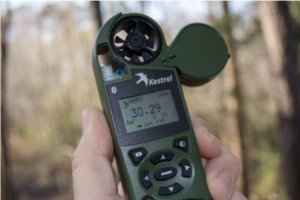
Devices like this Kestrel have sensors to determine actual station pressure while smartphones require manual entry or an internet connection to get it from a nearby weather station.
Ballistic Coefficient
Every bullet (projectile) has a ballistic coefficient (BC) expressed as a number between zero and one. You can think of it as a representation of how slippery the bullet is in flight or how good a particular bullet is at overcoming air resistance. The ballistic coefficient tells us how much or little a bullet slows down over time while in flight.
High ballistic coefficient numbers are associated with very aerodynamic projectiles. Low numbers reflect fat and draggy bullets like .45 wadcutters. So, if you launched a trashcan lid downrange with the underside facing forward, you would have a projectile with an obscenely low ballistic coefficient. If you launched a pencil, sharpened lead point forward, that would have a much higher ballistic coefficient.
You don't have to calculate BC using inputs like mass, cross section diameter, and shape — manufacturers will provide the number for you.
Drag Models
Once we have a value that describes the air resistance of a particular bullet, it's time to apply some complex math that models its behavior in flight. This set of calculations and formulas that make no sense whatsoever to use normal folks is called a drag model. It's the mathematical equation that predicts the exact trajectory curve.
The problem is that there are major differences in the shape of bullets, so one drag model isn't good enough to predict the behavior of bullets with different shape characteristics. For example, some bullets have a pointed tip and a flat base. Others, especially ones suited to long-range use, have boat-tail bases designed to lower wind resistance.
The standard default drag model is called G1. Most of the time, that's what you'll find on manufacturer websites. It works pretty well across the board, although if you want accurate predictive modeling, you'll want to use a different model, like G7. That one is designed specifically for bullets with boat tail shape.
Here's the takeaway. There are different ballistic coefficients for the same bullet depending on the drag model you're using. When entering a drag model into your ballistic computer, always be sure to match the ballistic coefficient with the drag model. For example, the Hornady 6.5mm 140-grain ELD Match bullet has a ballistic coefficient of .646 using the G1 drag model. The G7 model uses a ballistic coefficient of .351 for the same bullet. If you enter .351 into a ballistic computer using a G1 model, you're going to miss. I might know this from personal experience!
One more thing: the ballistic coefficient changes with velocity, so really fancy models account for a changing coefficient as the bullet slows down. At risk of running out of word space here, we'll leave that for the time being. You generally don't need to enter different numbers in your computer.
Muzzle Velocity
One of the biggest factors in the trajectory calculation is muzzle velocity. Ideally, you'll want to capture the actual velocity of your bullet from your rifle. If you don't have a chronograph, then you can use the manufacturer's rated velocity for that cartridge. Just be aware that it's going to be different from the actual from your gun in your local atmospheric conditions and the difference will throw the results off a bit. However, most calculators allow you to enter the placement of actual hits down range and will automatically correct the input muzzle velocity based on the actual bullet drop results.
If you measure your own, you'll need to input not only the velocity but the distance to the chronograph. That allows the software to calculate the speed at the muzzle itself.
Caliber
Depending on the type of ballistic computer you're using, you might be able to simply choose a bullet and cartridge combination from a library, such as an American Eagle 55-grain FMJ. Or, if you use a device like a Kestrel weather meter with ballistic software, you might need to describe the attributes of the bullet and its performance in detail. So, if you must describe the bullet from scratch, you need to use the actual bullet diameter, not the caliber "name."
Station and Barometric Pressure
Bullet flight paths depend a lot on the pressure in the immediate environment where they are fired. The actual measured pressure where you are standing right now is called station pressure. For example, sitting here at my desk today, the station Pressure is 29.976 hg.
Barometric pressure is a bit different, so it's important not to mix it up with station pressure when calculating ballistics. Barometric pressure is station pressure adjusted to sea level. If you and I live fairly close, but your house is on top of 1,000-foot stilts, our station pressure readings will be different. Using Barometric pressure allows us to evaluate the overall pressure picture for an area by adjusting station pressure to a sea-level equivalent.
Higher pressure causes bullets to fly slower and drop more. For example, if I fired a Hornady 6.5mm 140-grain ELD Match bullet from my desk where the station pressure is currently 29.98 Hg, at 1,000 yards down range it will drop 301.16 inches. If David Copperfield shows up and instantly increases the station pressure here to 32.00 Hg, that same shot will drop 313.86 inches.
Temperature
When it’s warmer, bullets fly faster and therefore drop less over a given distance. Most ballistic tools will need the current temperature as an input. More sophisticated ones will want to know the temperature (and all of the other atmospheric data) at the time the rifle was zeroed as well.
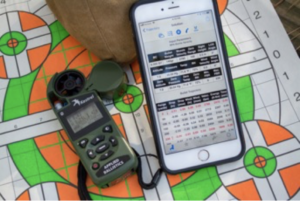
The two most popular ballistic computer options are standalone systems like the Kestrel and smartphone applications. Both have their advantages.
Wind Speed and Direction
Wind speed is an easy one with only a small bit of confusion. It's fairly obvious that a crosswind will blow a bullet off target. At short ranges, the effect is negligible. At longer ranges, even a 10mph crosswind can make a huge difference. That 6.5mm Creedmoor shot would drift 67.48 inches to the side at 1,000 yards.
Most wind terminology calls for the origin of the wind. So, a three o'clock wind would be coming from your right and blowing towards the left. However, some software flips that and considers the direction that the wind is moving. So, a three o'clock wind would be blowing left to right. Just be sure to check your ballistic computer to see which terminology it uses.
Zero Distance
The Zero distance is the range where you zero your rifle and scope to impact right on the crosshairs. With any scope, the optic will see a perfectly straight line to the target. That means that, relative to the scope line of sight, the barrel is pointed slightly up to allow the bullet to intersect the line of sight at your zero distance. If you zero at 100 yards, you are aiming your barrel up so that it appears to rise to the line of sight.
Scope Height
Closely related to zero distance is the scope height. To calculate the arc of your shot, the software needs to know how much higher the center of your scope is relative to the center of the bore. That’s one of the factors that determine the angle between your bore and the scope line of sight. If the scope is really high from the bore, then the barrel will be flinging the shot up at a steeper angle to meet the line of sight and the software will have to account for that.
Spin Drift
Rifles spin bullets like a football, so they fly stable and straight. When an object spins, a mystical force of physics makes them move sideways in the direction of the spin. At shorter distances, the effect is negligible, but far down range, the spin drift impact becomes significant. For the 6.5mm Creedmoor example we've been using here, the spin drift movement is about 7.56 inches at 1,000 yards.
To account for spin drift, you'll need to enter the bullet length and rate of twist of the barrel. Since most manufacturers don't publish the bullet length that means you'll have to measure or go to a third-party data website like JBMBaliistics.com.
Coriolis Effect
Since the earth spins, it literally moves out from under the flight path of your projectile as it's in the air, so your stationary target is actually a moving target. If your target is on the equator, it's moving at just about 1,000 miles per hour. If you are also on the equator and shooting along a parallel path to it, then Coriolis effect doesn't matter. However, if your shot to target line is not parallel to the equator, your target is moving relative to your shot. In our example case, the 6.5mm projectile is in the air for 1.47 seconds, so you might have to adjust for Coriolis effect about .07 milliradians or 2.52 inches. Fortunately, your ballistic software handles that.
As for inputs, you'll need to tell your device the compass direction of your shot so the computer knows the angle of flight relative to the earth's rotation. Some of the devices we'll discuss in a minute have internal compasses and allow you to simply point in the direction of your target to capture that information.
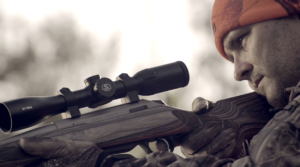
Many ammunition and optics companies, such as Styrka, offer ballistic calculations apps for smartphones so shooters can have information at their fingertips at the range or in the field. (Photo: Styrka)
Zero and Shooting Data
With more sophisticated calculators, all of the inputs we've discussed need to be captured when you zero the rifle. That provides the baseline from which future shooting events can be calculated. For example, if you zero your rifle at sea level on an 80-degree day, performance will vary dramatically if you need to calculate trajectory at 6,000 feet on a 35-degree day. The ballistic software will make those adjustments for you.
There are many other input factors and output options, but these are the basics and will get you well on your way. Now let's look at some ballistic calculator options and discuss the pros and cons of different approaches.
Types of Calculators
There are three major approaches to calculating the ballistics of a rifle and ammo combination, web calculators, smartphone software, and ballistic weather meter devices.
Web Calculators
Most ammunition manufacturers offer a web-based ballistic tool to help you understand how their ammunition will perform at various ranges with different elevation and wind conditions. Most of these tools are usable with bullets from other manufacturers too, so by using this type of solution you won't necessarily be limited to just one brand of ammunition.
Smartphone Software
The examples shown here are from the Ballistics Advanced Edition app for iOS. It's not available for Android, but another outstanding app, Applied Ballistics, has versions for both Android and iOS devices. There are many other options, including Strelok, Shooter, and iSnipe just to name a few.
The big advantage of using a Smartphone app is that you get all the user-friendliness and ease of use capabilities of that platform. The displays are great, and the good apps offer not just numerical output but charts and graphs to show you exactly what's going on. Add the capability for the storage of comprehensive databases of bullet profiles and you have everything you need.
The tradeoff is that while smartphones can use accelerometers and internal compasses to determine direction and inclination of the shot, they don't have direct atmospheric condition sensors. You have to manually enter data like station pressure and temperature. Some apps can ping the internet using your GPS location to get data from the nearest weather station. This isn't always an accurate option if you're out in the boonies far from the grid.
Devices
The Kestrel is the 900-pound gorilla in the ballistic weather meter market. The company's Kestrel 5700 Elite Meter with Applied Ballistics software does it all. The device has sensors to detect temperature, wind speed and direction, compass heading for the shot to adjust for Coriolis effect, station pressure, humidity, and more. All of this information is fed into the integrated ballistic software to instantly calculate windage and elevation adjustments required for a perfect shot.
Best of Both?
Kestrel and other weather meter companies have begun to leverage Bluetooth technology, allowing their tools to automatically transmit real-time atmospheric information to smartphone apps. Not only does this approach leverage the strengths of each type of device, it allows remote placement of the weather sensor. You can mount that in a tree or tripod in the ideal position to gather conditions information and keep the smartphone handy next to your rifle. With evolving standards for wireless communication, systems allow integration of rangefinder devices, so all environmental inputs are automated.
For successful shooting at distances past a few hundred yards, ballistic calculations are a must-have item. The trick is knowing the capabilities they bring and being able to communicate the pros and cons of different approaches to potential customers. The LINK standard that allows connectivity between Kestrel and smartphone applications is also the mechanism used by Bushnell's CONX range finder.
With a little planning, you can offer customers a sophisticated long-range shooting system.
